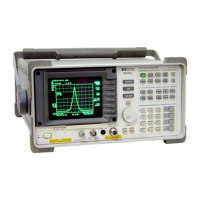Note
When the FFT measurement is active, pressing the
CMEAS/USER)
key will cycle
between the MEASUSER and FFT menus.
4.7
MKR
1.817
LHZ
REF
.B
dBrn
RTTEH
i@
dB
-45.25
dBrn
No
u5er
SMPL
Men”
LOG
2,
:
.:
I
I
FFT
START
B
HZ
FFT
STOP 6.667
k”Z
RES
BW
18
k”Z
“BW 9.8
k”Z
SWP
38.8 m5e.2
R
Figure 4-2. Percent Amplitude Modulation Measurement
Example 2: Use the automatic FFT measurement to look at 60 Hz AM modulation.
1. Connect a signal generator to the spectrum analyzer INPUT
509.
Adjust the signal generator
to produce an AM signal with a 60 Hz modulation frequency.
2. Press
[FREQUENCY)
and set the spectrum analyzer center frequency to the frequency of the
modulated input signal. Press
m),
10
m.
Press
[FREQUENCY)
to keep the signal on the
spectrum analyzer display.
3.
Press
[MEAS~USER),
FFT Menu, and MARKER
+
AUTO FFT . This initiates the FFT function and
activates a marker.
4. Use the knob to place the marker on the AM modulated signal and press
MARKER--+ AUTO FFT again. The spectrum analyzer will perform the following steps:
a. Save the present instrument state in state register 8.
b. Reduce the span to zoom in on the signal.
c. Set the detector mode to sample.
d. Set the scale to linear.
e. Change the span
to zero
span.
f. Start the continuous FFT function.
g. Set the FFT stop frequency to 10 kHz.
5. Press FFT STOP
FREQ
, 250
a).
This sets the spectrum analyzer to include the fourth
harmonic of the 60 Hz modulation signal on the screen.
6. To confirm that the resolution bandwidth and video bandwidth are correct for measuring the
modulation amplitude, use the following procedure:
a. Press
m
and use the knob to move the marker to the desired modulation signal. In
this example, place the marker on the 60 Hz fundamental modulation signal.
Note
For HP 8590L with Option 713 or HP 8592L with Option 713 the resolution
bandwidth must be left at about 100 kHz to accommodate frequency drift of
the spectrum analyzer. If you are using an HP 8590L with Option 713, or an
HP 8592L with Option 713, do not do step b.
Making Measurements 4-5

